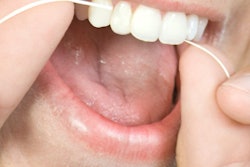
Dentists and hygienists tell their patients every day to use dental floss or an interdental cleaner to clean between their teeth. However, how much evidence is there that these devices, plus toothbrushing, do their jobs well? Researchers updated a comprehensive review of these devices' effectiveness to find out.
They included more than 30 studies with almost 4,000 adult participants and found that both floss and interdental cleaners may be effective at reducing gingivitis, but the review authors could not state definitely that floss reduced plaque.
"Using floss or interdental brushes in addition to toothbrushing may reduce gingivitis or plaque, or both, more than toothbrushing alone," wrote the authors, led by Helen Worthington, PhD, of the division of dentistry at the School of Medical Sciences at the University of Manchester Faculty of Biology, Medicine and Health in the U.K. (Cochrane Database of Systematic Reviews, April 10, 2019).
Difficult to reach
Cleaning areas between teeth (interdentally) is difficult for toothbrushes, so different devices are used. However, are devices such as dental floss, interdental brushes, tooth cleaning sticks, and water pressure devices (oral irrigators) effective at cleaning between teeth?
Researchers of the new review searched electronic databases for studies published up to January 16, 2019, to see if the literature offered any answers. They found 15 studies that evaluated floss plus toothbrushing compared with toothbrushing only.
“Using floss or interdental brushes in addition to toothbrushing may reduce gingivitis or plaque, or both, more than toothbrushing alone.”
According to low-certainty evidence, using floss in addition to toothbrushing reduced gingivitis at one, three, and six months, the review authors reported. It is unclear if using floss reduces plaque.
They also found evidence of very low certainty from two studies that using an interdental brush, in addition to a toothbrush, reduced gingivitis at one month. Other low-certainty evidence suggested that interdental brushes may reduce plaque more than toothbrushing alone.
In addition, two studies with low-certainty evidence found that using wooden cleaning sticks, plus toothbrushing, reduced bleeding sites but not plaque at three months.
Toothbrushing plus oral irrigation may reduce gingivitis in the short term, but no evidence supported this in the medium term, according to five studies. The review authors also reported that studies that measured adverse events found no serious effects.
Low certainty
The review authors cautioned that the evidence is low to very low certainty and that the effects may not be clinically important. Future trials should report participant periodontal status according to the new periodontal diseases classification, they noted. The studies should also last long enough to measure interproximal caries and periodontitis.
Nevertheless, the reviewers concluded that using floss or interdental brushes in addition to toothbrushing may reduce gingivitis or plaque, or both, more than toothbrushing alone. They also commented that interdental brushes might be the most effective treatment.
"Interdental brushes may be more effective than floss," the authors wrote.



















